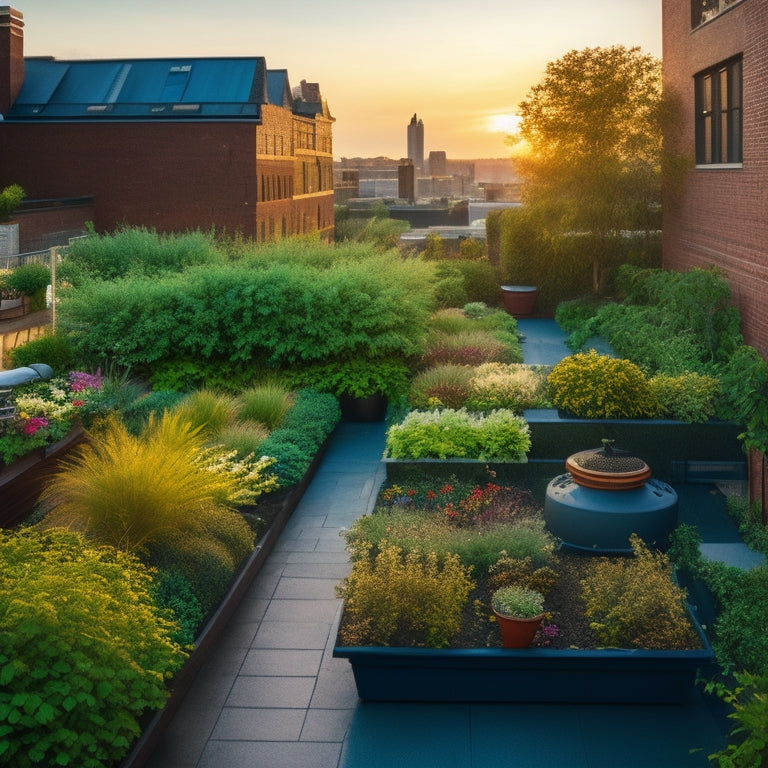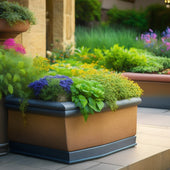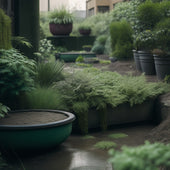
Optimizing Rooftop Garden Irrigation for Maximum Yield
Share
You need an enhanced rooftop garden irrigation system to achieve peak yield. Start by understanding the unique challenges of wind, temperature fluctuations, and limited soil depth. Then, consider drip irrigation systems, which deliver water directly to plant roots, reducing waste by up to 50%. Integrate smart technologies like soil moisture sensors, weather-based irrigation, and smart controllers to automate watering schedules based on real-time data. Rainwater harvesting can also reduce your water bill and environmental impact. By implementing these strategies, you'll be on your way to a highly efficient irrigation system that ensures healthy plant growth. Now, learn how to fine-tune your approach for best results.
Rooftop Garden Irrigation Basics
Designing an efficient rooftop garden irrigation system necessitates a thorough understanding of the distinct challenges and considerations that set it apart from traditional in-ground gardening. You'll need to account for factors like wind, temperature fluctuations, and limited soil depth, which can impact soil moisture levels and watering frequency.
When it comes to soil moisture, you'll want to optimize your irrigation system to deliver the correct amount of water to your plants without over- or under-watering. This can be achieved by monitoring soil moisture levels regularly, either manually or through automated sensors.
In terms of watering frequency, rooftop gardens often require more frequent watering due to the shallow soil depth and high evapotranspiration rates. You'll need to determine the best watering schedule for your specific climate, plant species, and soil type. Consider factors like weather patterns, plant water requirements, and soil moisture levels to determine the most effective approach.
Drip Irrigation Systems Compared
When selecting an irrigation system for your rooftop garden, you'll likely consider drip irrigation as a top contender, given its water-efficient reputation and ability to deliver water directly to the roots of your plants, minimizing evaporation and runoff. This method's watering efficiency is unmatched, as it reduces water waste by up to 50% compared to traditional sprinkler systems.
By delivering water directly to the roots, drip irrigation ensures ideal soil moisture levels, which is crucial for healthy plant growth.
There are two primary types of drip irrigation systems: inline emitter systems and point-source emitter systems. Inline emitter systems feature emitters spaced at regular intervals along the tubing, providing uniform water distribution. Point-source emitter systems, on the other hand, use individual emitters placed at each plant, allowing for more precise water delivery.
Both systems offer excellent watering efficiency and can be customized to suit your rooftop garden's specific needs. By understanding the differences between these systems, you can make an informed decision and enhance your irrigation setup for maximum yield.
Smart Watering Technologies Today
With the rise of rooftop gardening, you're likely to benefit from integrating smart watering technologies into your irrigation system, which can optimize water usage and plant growth through real-time monitoring and automated adjustments. These advanced systems utilize data from various sources, including soil moisture sensors and weather forecasts, to ensure your plants receive the right amount of water at the right time.
| Technology | Benefits | Application |
|---|---|---|
| Soil Moisture Sensors | Accurate water level monitoring, reduced overwatering | Integrated into irrigation controllers or used as standalone devices |
| Weather-Based Irrigation | Automated watering schedules based on real-time weather data | Ideal for rooftop gardens with varying weather conditions |
| Smart Controllers | Centralized monitoring and control of irrigation systems, remote access | Suitable for large-scale rooftop gardens or multiple garden setups |
Rainwater Harvesting Benefits
By incorporating rainwater harvesting into your rooftop garden's irrigation system, you can greatly reduce your water bill and reliance on municipal water supplies. This approach not only saves you money but also contributes to environmental sustainability.
Collecting and storing rainwater for irrigation reduces the demand on potable water sources, decreasing the energy required to treat and transport water. This, in turn, minimizes the carbon footprint of your rooftop garden.
Rainwater harvesting is an effective way to conserve water, a precious resource. By utilizing rainwater, you're reducing the amount of stormwater runoff, which can carry pollutants into nearby waterways. Additionally, rainwater is free from chemicals and minerals found in municipal water, making it a better option for your plants.
When designing your rainwater harvesting system, consider factors like roof size, material, and slope, as well as storage tank capacity and irrigation system requirements. With proper planning and installation, you can create a sustainable and efficient irrigation system that benefits both your rooftop garden and the environment.
Automated Irrigation Controllers
You can optimize your rooftop garden's irrigation system by installing an automated irrigation controller. This technology allows for precise scheduling and customization of watering sessions based on factors like soil moisture levels, temperature, and plant species.
This advanced system enables you to implement effective water-saving strategies, reducing waste and ensuring your plants receive the right amount of water. With an automated controller, you can program multiple zones with unique watering schedules tailored to the specific needs of different plants and soil types.
Climate-responsive solutions are integrated, allowing the controller to adjust watering schedules based on real-time weather data and forecasted patterns. This means your rooftop garden will receive the appropriate amount of water even when you're not there to monitor it.
Automating your irrigation system not only conserves water but also reduces the risk of overwatering, which can lead to root rot and other problems.
Frequently Asked Questions
How Often Should I Inspect My Rooftop Garden Irrigation System?
You should inspect your rooftop garden irrigation system every 2-4 weeks to ensure best watering efficiency, checking for clogs, leaks, and proper drip irrigation function, and schedule maintenance accordingly to avoid system failures.
Can I Use a Single Irrigation Timer for Multiple Zones?
Like a conductor leading an orchestra, you're seeking harmony among multiple zones with a single irrigation timer. Confirm timer compatibility, then design an efficient system for even water distribution, avoiding zones competing for resources like rival soloists.
Are There Any Rooftop Garden Irrigation Systems Suitable for Windy Areas?
You'll need an irrigation system designed for windy areas, like those with weighted drippers or anti-siphon valves, to prevent water loss in rooftop gardens; look for drip irrigation systems that prioritize water conservation.
How Do I Prevent Mineral Buildup in My Irrigation System Pipes?
You'll prevent mineral buildup in your irrigation system pipes by using a water filter, regular maintenance, and acidification treatments, ensuring efficiency and preventing clogs, while also maintaining good water quality.
Can I Integrate My Irrigation System With Other Smart Home Devices?
You can seamlessly integrate your irrigation system with other smart home devices, exploring various integration possibilities and ensuring compatibility for enhanced smart home automation, which boosts efficiency and streamlines your entire system.
Related Posts
-

5 Essential Drainage Tips for Block Planters
When using block planters, you'll want to guarantee effective drainage to prevent waterlogging and root rot. Start by...
-

5 Essential Drainage Tips for Block Planters
When using block planters, you'll want to guarantee effective drainage to prevent waterlogging and root rot. Start by...
-

5 Essential Drainage Tips for Block Planters
When using block planters, you'll want to guarantee effective drainage to prevent waterlogging and root rot. Start by...
-

5 Essential Drainage Tips for Block Planters
When using block planters, you'll want to guarantee effective drainage to prevent waterlogging and root rot. Start by...
-

5 Essential Drainage Tips for Block Planters
When using block planters, you'll want to guarantee effective drainage to prevent waterlogging and root rot. Start by...
-

5 Essential Drainage Tips for Block Planters
When using block planters, you'll want to guarantee effective drainage to prevent waterlogging and root rot. Start by...
-

5 Essential Drainage Tips for Block Planters
When using block planters, you'll want to guarantee effective drainage to prevent waterlogging and root rot. Start by...
-

5 Essential Drainage Tips for Block Planters
When using block planters, you'll want to guarantee effective drainage to prevent waterlogging and root rot. Start by...
-

5 Essential Drainage Tips for Block Planters
When using block planters, you'll want to guarantee effective drainage to prevent waterlogging and root rot. Start by...
-

5 Essential Drainage Tips for Block Planters
When using block planters, you'll want to guarantee effective drainage to prevent waterlogging and root rot. Start by...
-

5 Essential Drainage Tips for Block Planters
When using block planters, you'll want to guarantee effective drainage to prevent waterlogging and root rot. Start by...
-

5 Essential Drainage Tips for Block Planters
When using block planters, you'll want to guarantee effective drainage to prevent waterlogging and root rot. Start by...
-

5 Essential Drainage Tips for Block Planters
When using block planters, you'll want to guarantee effective drainage to prevent waterlogging and root rot. Start by...
-

5 Essential Drainage Tips for Block Planters
When using block planters, you'll want to guarantee effective drainage to prevent waterlogging and root rot. Start by...
-

5 Essential Drainage Tips for Block Planters
When using block planters, you'll want to guarantee effective drainage to prevent waterlogging and root rot. Start by...
-

5 Essential Drainage Tips for Block Planters
When using block planters, you'll want to guarantee effective drainage to prevent waterlogging and root rot. Start by...
-

5 Essential Drainage Tips for Block Planters
When using block planters, you'll want to guarantee effective drainage to prevent waterlogging and root rot. Start by...
-

5 Essential Drainage Tips for Block Planters
When using block planters, you'll want to guarantee effective drainage to prevent waterlogging and root rot. Start by...
-

Why Urban Gardens Need Better Planter Drainage Systems
When you neglect to install a well-designed drainage system in your urban garden, you're fundamentally sentencing you...
-

Why Urban Gardens Need Better Planter Drainage Systems
When you neglect to install a well-designed drainage system in your urban garden, you're fundamentally sentencing you...
-

Why Urban Gardens Need Better Planter Drainage Systems
When you neglect to install a well-designed drainage system in your urban garden, you're fundamentally sentencing you...
-

Why Urban Gardens Need Better Planter Drainage Systems
When you neglect to install a well-designed drainage system in your urban garden, you're fundamentally sentencing you...
-

Why Urban Gardens Need Better Planter Drainage Systems
When you neglect to install a well-designed drainage system in your urban garden, you're fundamentally sentencing you...
-

Why Urban Gardens Need Better Planter Drainage Systems
When you neglect to install a well-designed drainage system in your urban garden, you're fundamentally sentencing you...
-

Why Urban Gardens Need Better Planter Drainage Systems
When you neglect to install a well-designed drainage system in your urban garden, you're fundamentally sentencing you...
-

Why Urban Gardens Need Better Planter Drainage Systems
When you neglect to install a well-designed drainage system in your urban garden, you're fundamentally sentencing you...
-

Why Urban Gardens Need Better Planter Drainage Systems
When you neglect to install a well-designed drainage system in your urban garden, you're fundamentally sentencing you...
-

Why Urban Gardens Need Better Planter Drainage Systems
When you neglect to install a well-designed drainage system in your urban garden, you're fundamentally sentencing you...
-

Why Urban Gardens Need Better Planter Drainage Systems
When you neglect to install a well-designed drainage system in your urban garden, you're fundamentally sentencing you...
-

Why Urban Gardens Need Better Planter Drainage Systems
When you neglect to install a well-designed drainage system in your urban garden, you're fundamentally sentencing you...
-

Why Urban Gardens Need Better Planter Drainage Systems
When you neglect to install a well-designed drainage system in your urban garden, you're fundamentally sentencing you...
-

Why Urban Gardens Need Better Planter Drainage Systems
When you neglect to install a well-designed drainage system in your urban garden, you're fundamentally sentencing you...
-

Why Urban Gardens Need Better Planter Drainage Systems
When you neglect to install a well-designed drainage system in your urban garden, you're fundamentally sentencing you...
-

Why Urban Gardens Need Better Planter Drainage Systems
When you neglect to install a well-designed drainage system in your urban garden, you're fundamentally sentencing you...
-

Why Urban Gardens Need Better Planter Drainage Systems
When you neglect to install a well-designed drainage system in your urban garden, you're fundamentally sentencing you...
-

Why Urban Gardens Need Better Planter Drainage Systems
When you neglect to install a well-designed drainage system in your urban garden, you're fundamentally sentencing you...
-

Why Urban Gardens Need Better Planter Drainage Systems
When you neglect to install a well-designed drainage system in your urban garden, you're fundamentally sentencing you...
-

Why Urban Gardens Need Better Planter Drainage Systems
When you neglect to install a well-designed drainage system in your urban garden, you're fundamentally sentencing you...
-

Why Urban Gardens Need Better Planter Drainage Systems
When you neglect to install a well-designed drainage system in your urban garden, you're fundamentally sentencing you...
-

Why Urban Gardens Need Better Planter Drainage Systems
When you neglect to install a well-designed drainage system in your urban garden, you're fundamentally sentencing you...
-

Why Urban Gardens Need Better Planter Drainage Systems
When you neglect to install a well-designed drainage system in your urban garden, you're fundamentally sentencing you...
-

Why Urban Gardens Need Better Planter Drainage Systems
When you neglect to install a well-designed drainage system in your urban garden, you're fundamentally sentencing you...
-

Why Urban Gardens Need Better Planter Drainage Systems
When you neglect to install a well-designed drainage system in your urban garden, you're fundamentally sentencing you...
-

Why Urban Gardens Need Better Planter Drainage Systems
When you neglect to install a well-designed drainage system in your urban garden, you're fundamentally sentencing you...
-

Why Urban Gardens Need Better Planter Drainage Systems
When you neglect to install a well-designed drainage system in your urban garden, you're fundamentally sentencing you...
-

Why Urban Gardens Need Better Planter Drainage Systems
When you neglect to install a well-designed drainage system in your urban garden, you're fundamentally sentencing you...
-

What Makes a Good Used Trowel for Planters
When searching for a good used trowel for planters, you'll want to prioritize corrosion-resistant materials like stai...
-

What Makes a Good Used Trowel for Planters
When searching for a good used trowel for planters, you'll want to prioritize corrosion-resistant materials like stai...
-

What Makes a Good Used Trowel for Planters
When searching for a good used trowel for planters, you'll want to prioritize corrosion-resistant materials like stai...
-

What Makes a Good Used Trowel for Planters
When searching for a good used trowel for planters, you'll want to prioritize corrosion-resistant materials like stai...
-

What Makes a Good Used Trowel for Planters
When searching for a good used trowel for planters, you'll want to prioritize corrosion-resistant materials like stai...
-

What Makes a Good Used Trowel for Planters
When searching for a good used trowel for planters, you'll want to prioritize corrosion-resistant materials like stai...
-

What Makes a Good Used Trowel for Planters
When searching for a good used trowel for planters, you'll want to prioritize corrosion-resistant materials like stai...
-

What Makes a Good Used Trowel for Planters
When searching for a good used trowel for planters, you'll want to prioritize corrosion-resistant materials like stai...
-

What Makes a Good Used Trowel for Planters
When searching for a good used trowel for planters, you'll want to prioritize corrosion-resistant materials like stai...
-

What Makes a Good Used Trowel for Planters
When searching for a good used trowel for planters, you'll want to prioritize corrosion-resistant materials like stai...
-

What Makes a Good Used Trowel for Planters
When searching for a good used trowel for planters, you'll want to prioritize corrosion-resistant materials like stai...
-

What Makes a Good Used Trowel for Planters
When searching for a good used trowel for planters, you'll want to prioritize corrosion-resistant materials like stai...
-

What Makes a Good Used Trowel for Planters
When searching for a good used trowel for planters, you'll want to prioritize corrosion-resistant materials like stai...
-

What Makes a Good Used Trowel for Planters
When searching for a good used trowel for planters, you'll want to prioritize corrosion-resistant materials like stai...
-

What Makes a Good Used Trowel for Planters
When searching for a good used trowel for planters, you'll want to prioritize corrosion-resistant materials like stai...
-

What Makes a Good Used Trowel for Planters
When searching for a good used trowel for planters, you'll want to prioritize corrosion-resistant materials like stai...
-

What Makes a Good Used Trowel for Planters
When searching for a good used trowel for planters, you'll want to prioritize corrosion-resistant materials like stai...
-

What Makes a Good Used Trowel for Planters
When searching for a good used trowel for planters, you'll want to prioritize corrosion-resistant materials like stai...
-

What Makes a Good Used Trowel for Planters
When searching for a good used trowel for planters, you'll want to prioritize corrosion-resistant materials like stai...
-

What Makes a Good Used Trowel for Planters
When searching for a good used trowel for planters, you'll want to prioritize corrosion-resistant materials like stai...
-

What Makes a Good Used Trowel for Planters
When searching for a good used trowel for planters, you'll want to prioritize corrosion-resistant materials like stai...
-

What Makes a Good Used Trowel for Planters
When searching for a good used trowel for planters, you'll want to prioritize corrosion-resistant materials like stai...
-

What Makes a Good Used Trowel for Planters
When searching for a good used trowel for planters, you'll want to prioritize corrosion-resistant materials like stai...
-

What Makes a Good Used Trowel for Planters
When searching for a good used trowel for planters, you'll want to prioritize corrosion-resistant materials like stai...


